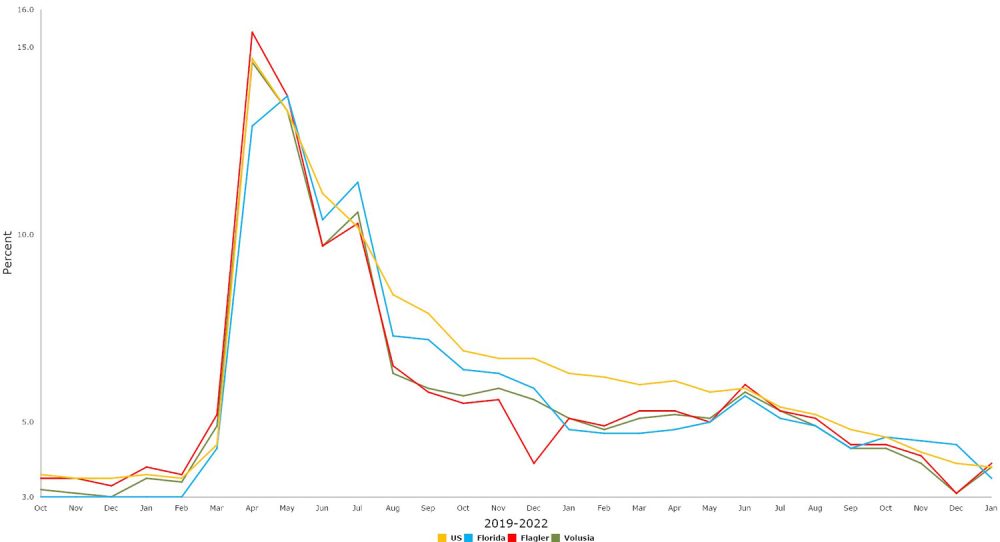
With Florida’s job totals back to pre-pandemic numbers, the state’s unemployment rate in December and January was 3.5 percent, according to a report released Monday by the state Department of Economic Opportunity.
The state initially estimated a 4.4 percent unemployment rate for December but dropped it to 3.5 percent Monday, largely because of annual U.S. Department of Labor revisions. The new numbers indicate a resurgence in most job sectors despite lingering impacts from the Covid-19 pandemic and mounting inflation.
The 3.5 percent rate for January reflected 364,000 people out of work from a labor force of 10.448 million. It was down from 6 percent in January 2021.
More importantly, the figures indicate the state has recaptured all 1.28 million jobs lost in early 2020 as the economy sputtered during the first impact of the coronavirus pandemic.
Flagler County’s unemployment rate rose to 3.9, from a revised 3.1 percent in December. Last month the state had initially reported Flagler’s unemployment rate as 3.8 percent, with 1,877 people unemployed. The revised figures for December are 3.1 percent, with 1,504 people unemployed.
Either way, Flagler’s current unemployment total of 1,877 is in fact better than it was on the eve of the pandemic, both because it is numerically lower (if by just a few individuals) and because since then, the labor force is greater by about 300 workers. Flagler County’s labor force, at 48,779, is still shy of the record set in 2021, when it hit 49,000 in October. However, the number of Flagler County residents with jobs–46,902–is almost 1,000 greater than it was in January 2020, just before the pandemic caused widespread job losses.
Two caveats: First, it only requires the logging of an hour’s paid work to qualify as employed. The figures do not distinguish between part time and full time work. Second, the number of people out of work reflects only those complying with the state’s restrictive requirements to qualify for unemployment, and only those who are part of the state’s 12-week unemployment compensation window–the stingiest window in the nation. Those who do not comply with the rules or run out of benefits are no longer counted among the unemployed. The federal government calculates the so-called alternative unemployment and underemployment rate for the states. That rate includes calculations for discouraged workers, those who have dropped out of the labor force, and those who are working part-time because they are unable to find full-time work. According to those calculations, Florida’s unemployment and underemployment rate is 8.7 percent.
Adrienne Johnston, chief economist at the Department of Economic Opportunity, said the federal-driven revisions showed the state recovered quicker than previously reported, with the state now below the federal unemployment rate for 14 consecutive months.
“We continue to see positive growth across all industries,” Johnston said. “It seems like people are highly encouraged to engage back into the labor force. So, overall, things are very positive. The outlook is looking good for Florida.”
The leisure and hospitality industry, which was hit hardest by the pandemic, has recovered 88 percent of the jobs lost.
Meanwhile, the number of jobs in the sectors of trade, transportation and utilities, professional business services, financial activities, construction and manufacturing have at least recaptured all the jobs lost during the pandemic.
“Both manufacturing and construction have gained jobs in Florida since February 2020, whereas these sectors have not yet recovered in the rest of the country,” Johnston said. “Florida has also seen strong growth and financial activities compared to the nation, which has not yet seen net job gains over this period.”
The revisions also indicate the state recaptured its pre-pandemic labor force numbers in June 2021, a month earlier than previously reported, while monthly jobless rates have declined or remained steady since July 2020. The revisions also showed the peak pandemic unemployment rate in May 2020 was 13.9 percent, rather than a previously reported 14.2 percent.
“This is still the highest rate on record for the state,” Johnston said.
The revisions also moved the state back below the federal jobless rate, which dropped from 3.9 percent in January to 3.8 percent in February, with the Department of Labor on March 4 estimating the nation added 678,000 jobs in February, atop the 481,000 in January and 588,000 for December.
Over the past year, Florida’s labor force has grown by 3.1 percent, compared to a 2.2 percent nationally, Johnston said.
With the new numbers, the biggest job gains over the past year have come in leisure and hospitality, up 17.4 percent, professional and business services, up 7.2 percent, and trade, transportation and utilities, up 5.7 percent.
Construction jobs were up 2.6. percent, manufacturing jobs increased by 3.9 percent, and jobs involving education and health services grew by 2.1 percent.
Statewide, the lowest January unemployment rate was in Monroe County, which includes the Florida Keys, at 2.3 percent, followed by St. Johns County at 2.6 percent.
Rural Hamilton and Putnam counties held the highest rates at 5.1 percent.
Among the state’s metropolitan statistical areas, the unemployment rate around Jacksonville was at 3.3 percent, with the Miami-Fort Lauderdale-West Palm Beach and the Tampa-St. Petersburg-Clearwater at 3.4 percent and the Orlando-Kissimmee-Sanford area at 3.8 percent.
Florida will update the employment numbers — reflecting mid-February conditions— on March 25.
–FlaglerLive and the News Service of Florida
![]()
Click to access florida-flagler-unemployment-january-2022.pdf





























Leave a Reply